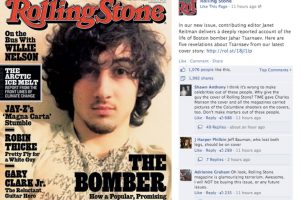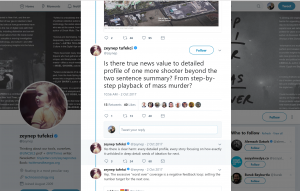By GRACE SMITH
Just a few days following the devastating school shooting at Marjory Stoneman Douglas High School in Parkland, Fla., police have foiled many copycat threats toward schools and their students.
Many of the charges have simply been for written threats to kill, but the message forms have ranged from pictures on Snapchat with guns declaring dates they would attack to a physical written note threatening teachers. The police have arrested and defused these threats, but a majority of the threats made were termed as jokes or seen as “funny” by their perpetrators.
This perception of the national tragedy by high school and middle school students could reflect a much larger issue when it comes to media coverage of major shooting incidents.

A screenshot of the Rolling Stone’s Facebook page following the publishing of their Boston Bomber cover.
The news media came under scrutiny for their treatment of national disasters largely due to The Rolling Stone‘s coverage of the Boston Marathon bombing incident on April 13, 2013.
They chose to put the Boston Marathon bomber Dzhokhar Tsarnaev’s face on the cover of their magazine and caused national outrage for glamorizing and popularizing Tsarnaev rather than respecting and focusing on the victims and the city’s recovery. It was somewhat comparative to young woman who send love letters to serial killers such as Ted Bundy or Jeffery Dahmer.
When it comes to national tragedies, the media has a responsibility to inform as regularly and as accurately as possible. But many people have urged networks and publications to not repeatedly print the accused’s face and name since the popularity and recognition is often what the perpetrators aim for when they do what they do.
Whether these kids wanted to scare their friends or see how their school’s react, a large amount of mass shootings are often inspired by the national attention previous disasters like Columbine or Sandy Hook receive.
The killers are instantly picked apart and their interests, friends, family, and possible motivations are published everywhere and they dominate the news. The Las Vegas shooter was a noted narcissist- what better way to satisfy the need for attention then to be discussed in the news for weeks?
This is also fault to the new age of 24-hour news cycle. With networks dedicated to instant, braking news updates every hour of the day, these incidents are rehashed over and over.
No Notoriety, a group that focuses on media coverage of mass killings asks the media to “limit” the name and images of a shooter except for instances where the suspect is at large. Let’s focus on the event, the victims and the heroes, and not make the killer a household name.

